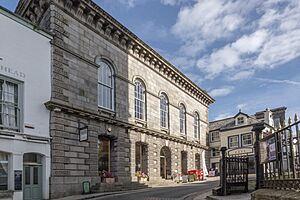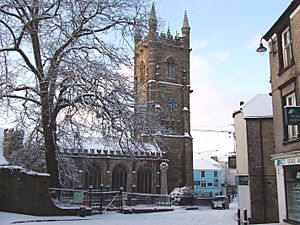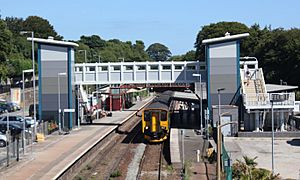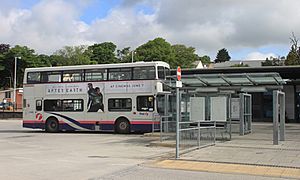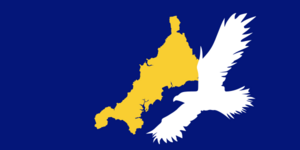St Austell facts for kids
Quick facts for kids St Austell
|
|
|---|---|
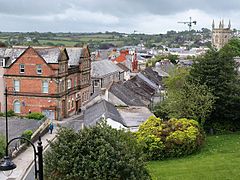 High Cross Street |
|
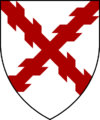 Coat of arms |
|
| Lua error in Module:Location_map at line 530: Unable to find the specified location map definition: "Module:Location map/data/Cornwall (mainland)" does not exist. | |
| Population | 20,900 (2021) |
| OS grid reference | SX011524 |
| Civil parish |
|
| Unitary authority | |
| Ceremonial county | |
| Region | |
| Country | England |
| Sovereign state | United Kingdom |
| Post town | ST. AUSTELL |
| Postcode district | PL25 |
| Dialling code | 01726 |
| Police | Devon and Cornwall |
| Fire | Cornwall |
| Ambulance | South Western |
| EU Parliament | South West England |
| UK Parliament |
|
| Website | www.staustell.co.uk |
St Austell (pronounced oss-tuhl or aw-stul) is a town in Cornwall, England. It is located about 10 miles (16 km) south of Bodmin. The town is also about 30 miles (48 km) west of the border with Devon.
In 2021, about 20,900 people lived in St Austell. The town is named after a 6th-century Cornish saint, St Austol.
Contents
History of St Austell
St Austell started as a small village around its church. It grew into a town when tin mining became very important in the 1700s.
How St Austell Got Its Name
The town is named after St Austol, a Cornish saint from the 500s. He was a student of another saint, St Mewan. A very old list from the Vatican shows "Austoll" as a Cornish parish saint. This means the church and village were there around 900 AD.
Early Records of the Town
St Austell is not mentioned in the Domesday Book from 1086. However, records show a church was dedicated here in 1262. Other records suggest a church existed as early as 1169. The church you see today was built in the 1200s and 1300s. It was made bigger in 1498–99. You can still see where the old and new parts join.
In the 1500s, St Austell was described as a small, poor village. Famous travelers like John Leland and Richard Carew did not see it as an important place. Later, Oliver Cromwell allowed the town to hold a market every Friday. This was a reward for a local gentleman who fought for him.
Growth from Mining
The village began to grow in the 1700s. The nearby Polgooth mine became known as the biggest tin mine in the world. Around 1760, a main road from Land's End to Plymouth passed through the town.
The discovery of china clay also helped St Austell grow. William Cookworthy found china clay in west Cornwall. More was found in the Hensbarrow hills north of St Austell. This mineral became very important for the town.
China clay mining soon became the main industry. It took over from tin and copper mining. This industry helped the town grow a lot, especially from the mid-1800s to early 1900s. Many people moved to St Austell for work when metal mining slowed down. This made the town's population much larger. More shops and businesses opened, creating more jobs. St Austell became one of Cornwall's most important business centers.
The town was also a big center for Methodism. By 1839, there were 37 non-conformist chapels in the town.
Modern Changes and Redevelopment
In the 1960s, a new shopping area was built in the town center. It had shops, offices, and flats. By the 2000s, this area looked old and needed updating. A big project costing £75 million began to rebuild it.
In 2007, the old Filmcentre cinema was torn down. The new development was named White River Place. New shops like New Look and Wilko opened there. However, the company building it faced problems in 2008.
The new White River Cinema opened in December 2008. It was the first cinema built in Cornwall in over 60 years. The Torchlight Carnival was brought back in 2009. It is now a popular event that brings many people to the town.
There are also plans for new homes around St Austell on old mining sites. This is called the St Austell and Clay Country Eco-town. In 2011, plans for a large beach resort at Carlyon Bay were also approved.
How St Austell is Governed
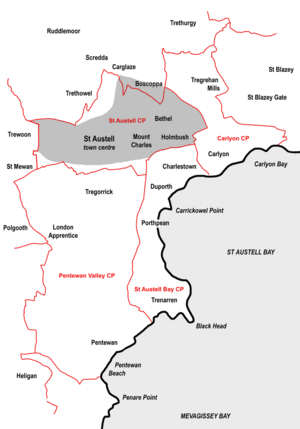
St Austell has its own coat of arms. It shows a red cross on a silver background.
Representing St Austell in Parliament
St Austell is part of the St Austell and Newquay area for Parliament. This area was created in 2010. Before that, it was part of the Truro and St Austell area. This change meant Cornwall got an extra seat in Parliament.
Economy and Tourism
St Austell is the main center for the china clay industry in Cornwall. This industry employs about 2,200 people. It brings in about £195 million in sales.
Local Businesses
The St Austell Brewery is a famous local business. It started over 150 years ago. It makes cask ale and supplies pubs in Cornwall and other parts of the country. Its most famous beer is St Austell Tribute. The brewery has a museum and visitor center that you can visit.
Visiting St Austell: Tourism
Tourism is very important to St Austell's economy. Many visitors come to see the nearby beaches. They also visit famous places like the Eden Project. This amazing place is built in an old clay pit. The Lost Gardens of Heligan are another popular attraction.
The China Clay Country Park is also nearby. It's in an old china-clay pit. It tells the story of the people who worked in the clay industry.
St Austell has many shops, including well-known high street stores and local independent shops. The town also has a small museum inside the St Austell Market House.
Landmarks and Buildings
Many of St Austell's buildings were designed by a famous Cornish architect named Silvanus Trevail.
Some of the town's notable buildings include:
- The Parish Church: A very old and impressive church.
- The Old Market Hall: Built in 1844, it has an Italian Renaissance style.
- Friends Meeting House: A simple granite building from 1829.
- Masonic Hall: Built in 1900.
- White Hart Hotel: This hotel once had special wallpaper of the Bay of Naples. It is now in the Victoria and Albert Museum.
- Holy Well at Menacuddle: A historic holy well.
Media and Communication
Television and Radio
Local TV news for St Austell comes from BBC South West and ITV West Country. You can also listen to local radio stations like BBC Radio Cornwall and Heart West. There is also a community radio station called CHAOS Radio.
Newspapers
The town has two weekly newspapers: the St Austell Guardian and the St Austell Voice.
Transport in St Austell
Train Travel
St Austell railway station opened in 1859. It is located on a hillside above the town. Two train lines were built to serve the china clay industry. One of these, the Newquay and Cornwall Junction Railway, is still partly open.
The main train line in St Austell is known for its viaducts. These are large bridges that carry the railway over valleys. The original wooden viaduct was designed by Isambard Kingdom Brunel. It was 115 feet (35 meters) high and 720 feet (220 meters) long. It was replaced by a stone viaduct in 1899.
Today, trains from St Austell go west to Truro and Penzance. They also go east to Plymouth and London. You can also catch trains to the North of England and Scotland.
Bus Travel
The town's bus station is right in front of the railway station. This makes it easy to switch between buses and trains. National Express coaches stop here. There is also a special bus that goes to the Eden Project. Local buses connect St Austell to nearby villages like Fowey and Mevagissey.
The bus station was updated in 2008. It now has seven stands. It shares facilities like a taxi rank and a cafe with the train station.
Roads
You can reach St Austell by several main roads. The A390 bypasses the town to the south. The A391 comes from Bodmin, and the A3058 comes from Newquay.
Education in St Austell
St Austell has three main high schools: Poltair School, Penrice Academy, and Brannel School. Brannel School is in the nearby village of St Stephen-in-Brannel. Many of these schools are joining a group called CELT (Cornwall Education and Learning Trust).
Cornwall College St Austell offers further and higher education. It includes the former St Austell Sixth Form Centre. The college is based at John Keay House. There are also several primary schools in the town.
Religious Sites
The main church in St Austell is now called Holy Trinity Church. It was originally dedicated to St Austol. The church you see today was mostly built in the 1400s. It is a large church because the area it served was also very big. The church tower is very impressive. It has carvings of the Twelve Apostles and other religious figures.
There are also holy wells at Menacuddle and Towan. A new organ was added to the church in 1880. The church is a Grade I listed building, which means it is very important historically.
Quakers in St Austell
There used to be a Quaker burial ground just outside the town. It was covered by earth when a new road was built in the 1960s. Some of the headstones were moved to the Friends meeting house in High Cross Street. This meeting house is still used today.
Sports in St Austell
St Austell has a long history with many sports, especially Cornish wrestling.
Cornish Wrestling
St Austell has been a major center for Cornish wrestling for hundreds of years. Wrestling tournaments were held in places like the Bull Ring and the Wrestling Downs. Many famous Cornish wrestlers came from St Austell, including Joseph Menear and Thomas Stone.
St Austell wrestlers were known for special moves like the "Hancock Slew." This move is now called the Flying Mare. It's a very dangerous throw! They were also known for the "Lock Arm" throw.
Today, there is a Cornish wrestling club in St Austell. It meets every Monday.
Other Sports
- Speedway: Speedway racing used to be popular in St Austell. The team was called the "St Austell Gulls". The sport was held at the Cornish Stadium and later at the Clay Country Moto Parc.
- Stock Car Racing: Stock car racing also took place at the Cornish Stadium. It hosted important championships.
- Greyhound Racing: A greyhound racing track was also at the Cornish Stadium from 1958 to 1986.
- Football: St Austell Football Club was formed in 1890. They have won several trophies, including the Cornwall Charity Cup.
- Rugby and Tennis: Tregorrick Park is home to St Austell RFC (rugby club) and St Austell Tennis Club. The rugby club has many teams, including youth teams.
- Cricket: Wheal Eliza cricket ground is home to St Austell Cricket Club. They have four senior teams and youth teams.
- Baseball: The St Austell Claycutters baseball club started in 2017. They play in the South West Baseball League.
- Golf: There are three 18-hole golf courses around St Austell: St Austell Golf Club, Carlyon Bay Golf Club, and Porthpean Golf Club.
Notable People from St Austell
- Alfred Leslie Rowse (1903–1997): A famous British historian and writer who grew up in St Austell.
- John Nettles (born 1943): An actor, known for TV shows like Bergerac and Midsomer Murders. He was raised in St Austell.
- Steve Baker (born 1971): A British politician, born in St Austell.
See also
 In Spanish: St Austell para niños
In Spanish: St Austell para niños


